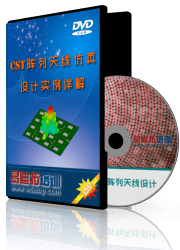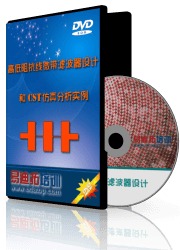- 易迪拓培训,专注于微波、射频、天线设计工程师的培养
Plasma Applicator - CST2013 MWS Examples

General Description
This simple microwave plasma applicator example shows how materials with dielectric dispersion of 2nd order can be taken into consideration. The behavior of a cold plasma with losses created by particle collisions can be described by the Drude model. Determining factors are the plasma frequency (which is directly related to the electron density of the plasma) and the collision frequency, which describes the probability of collisions between electrons and neutral atoms or molecules.
The applicator contains a quartz tube which is evacuated. The incoming microwave can ignite a plasma. Inside the quartz tube different plasma densities dependent on the radius are given. The values can be extracted from measurements or calculated by using Bessel functions, which could be done by making use of a VBA macro.
Structure Generation
The main settings for the plasma applicator can be done using the waveguide template, defining the PEC boundary and background material as well as the units settings. Due to the symmetry of the structure one magnetic symmetry plane is activated to save simulation time.
The model is constructed by defining a brick as the coupling waveguide and a cylinder representing the quartz tube. Using the shell facility the several plasma layers are realized.
Solver Setup
At one end of the given coupling waveguide a waveguide port is defined to excite the plasma applicator. The excitation signal is a Gaussian shaped pulse referring to the frequency range from 1.9 to 4.1 GHz.
In order to analyze the field distribution inside the different plasma layers several electric 3D field monitors are defined at different frequency points.
Post Processing
The monitored 3D fields are listed in the navigation tree in the folder 2D/3D Results. Regarding the fields inside the tube represents the plasma effects at different frequency points. It can be seen how some layers of the plasma get 'overcritical', that means the plasma frequency is higher than the operation frequency and the electromagnetic wave cannot penetrate the plasma layer anymore or is strongly damped inside.
In addition the time signals and the corresponding scattering parameters of the transient calculation can be found in the folder 1D Results.
CST微波工作室培训课程套装,专家讲解,视频教学,帮助您快速学习掌握CST设计应用
上一篇: Shaped End Radiator - CST2013 MWS Examples
下一篇: Ship - CST2013 MWS Examples
CST中文视频培训教程 | More...
 最全面、最专业的CST微波工作室视频培训课程,可以帮助您从零开始,全面系统学习CST的设计应用【More..】
最全面、最专业的CST微波工作室视频培训课程,可以帮助您从零开始,全面系统学习CST的设计应用【More..】
频道总排行
- Rectangular Waveguide Tutorial
- FSS: Simulation of Resonator
- CST2013 MWS Examples: Thermal C
- Dipole Antenna Array - CST201
- CST MWS Examples - CST2013 M
- Microstrip Radial Stub - CST2
- Dielectric Resonator Antenna -
- Interdigital Capacitor - CST20
- CST2013 MWS Examples: Biological
- Lossy Loaded Waveguide - CST2











 沪公网安备 31011202014168号
沪公网安备 31011202014168号
 1427313829
1427313829 旺旺在线
旺旺在线 Skype Online
Skype Online 13761612886
13761612886 官方淘宝店
官方淘宝店
